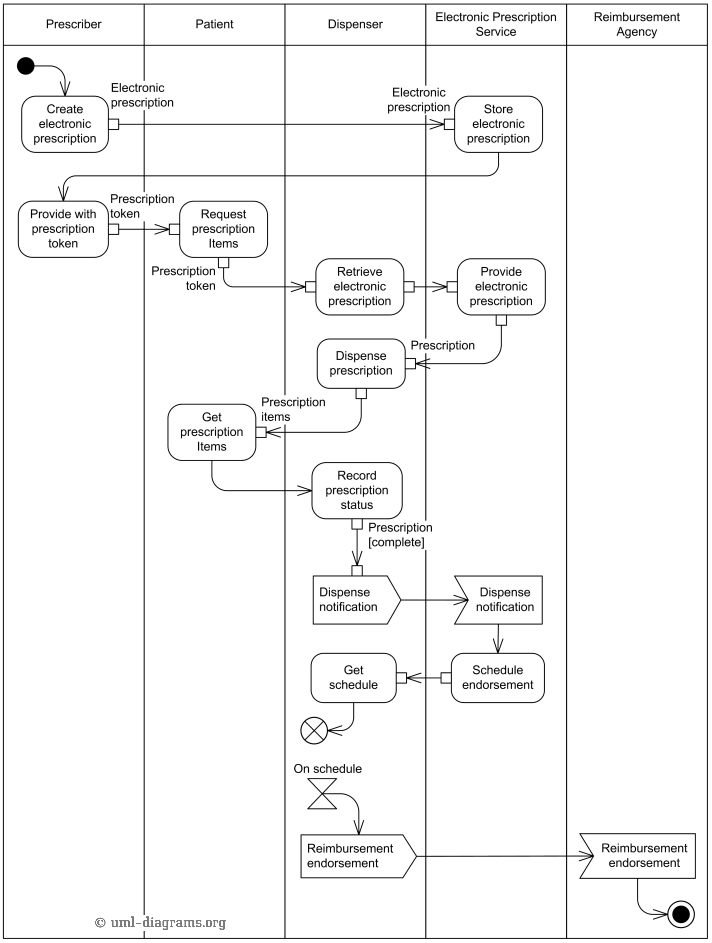Electronic Prescriptions
UML Activity Diagram Example
This is an example of activity diagram for electronic prescriptions. This example is based on documentation for the impressive Electronic Prescription Service (EPS) Release 2 developed by the NHS Connecting for Health (NHS CFH) as a part of the National Programme for IT in the National Health Service (NHS) in England. Note, that this page represents informal UML diagram example. Please refer to the NHS CFH to get a range of official communications and guidance materials.
The Electronic Prescription Service enables prescribers - such as general practitioners (GPs) and practice nurses - to send prescriptions electronically to a dispenser (such as a pharmacy) of the patient's choice.
As with all NHS Connecting for Health services, access to the EPS is controlled through the use of the NHS Smartcard having user's name, photograph and unique identity number printed on, and with embedded smart chip. The Smartcard gives individual users different levels of access depending on their role.
Prescriber logs onto the clinical system using their Smartcard and passcode, chooses medication or medical appliance for the patient, adds prescribing endorsements where required, and applies electronic signature to authorize the electronic prescription. Electronic prescription is transmitted to the EPS. Prescription token is printed where required. Authorized person hands prescription token to patient where necessary.
Paper copies of electronic prescriptions are called tokens. They act as a hard copy of the details contained within the electronic prescription. There are two types of tokens - 'prescription tokens' and 'dispensing tokens'. When the EPS is fully introduced, paper copies of electronic prescriptions will no longer be needed but should still be available by request, whenever necessary.

An example of UML activity diagram for electronic prescriptions.
A dispenser (or dispensing contractor) is any organization that dispenses NHS primary care prescriptions to patients, such as a community pharmacy, a dispensing appliance contractor or a dispensing GP practice. With EPS, only prescriptions sent to a patient’s nominated dispensing contractor can be signed and sent electronically.
Dispenser retrieves electronic prescriptions from the EPS. It could be done in three ways either by automatic download (e.g. overnight), by manually entering the prescription ID printed on the token, or by scanning a barcode on a prescription token. Dispensing token is printed if required. Prescription items are issued to the patient or patient’s representative.
Dispenser should record the status of each of the prescription items as one of the 'dispensed', 'not dispensed', 'owing' or 'partial'. In order to complete the dispensing process the whole prescription has to be completed, meaning that all prescribed items must be marked as either 'dispensed' or 'not dispensed'. Some clinical systems will automatically record the status of dispensed items.
If dispensing process is complete, dispenser should send dispense notification to the Electronic Prescription Service. The message informs the EPS which medication has/has not been supplied to the patient. A schedule will be issued for pharmacists to follow as to when to submit the electronic reimbursement endorsement message. The electronic reimbursement endorsement message can only be sent once the dispense notification message has been sent for the electronic prescription.
To support the reimbursement claim process, the EPS will allow dispensers to electronically submit reimbursement endorsement messages to the reimbursement agency for the dispensed electronic prescriptions so that the reimbursement agency can make a payment. The messages are sent according to the reimbursement agency scheduling.